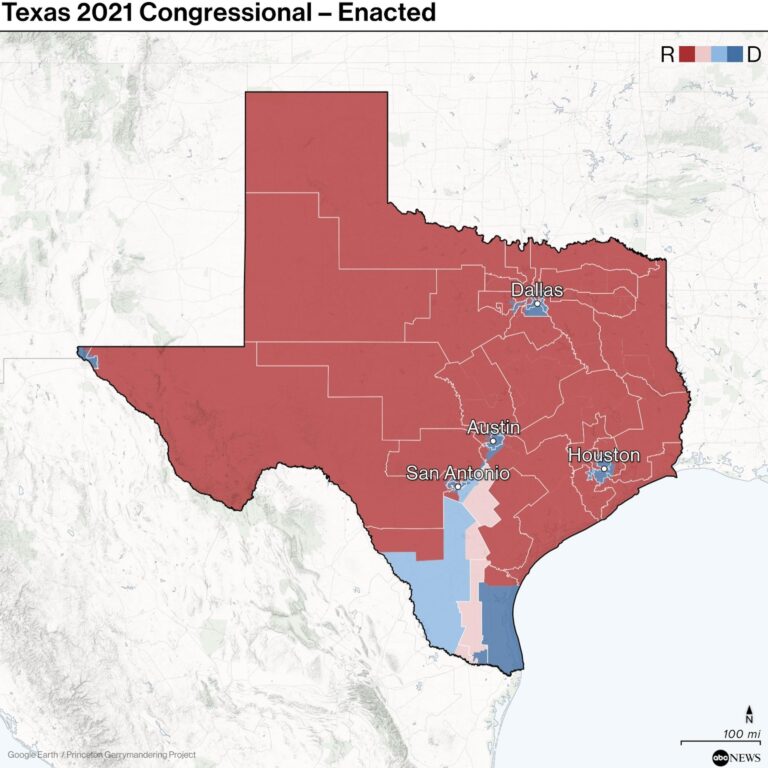How Texas Redistricting is Redefining the 2024 U.S. House Elections
Texas Redistricting: A Decade-Long Political Transformation
Following the 2020 Census, Texas is in the midst of a highly consequential redistricting process that will shape its congressional representation for the next ten years. This complex endeavor involves lawmakers and advocacy groups fiercely negotiating district boundaries, often with the intent to favor specific political parties‚ÄĒa tactic commonly referred to as gerrymandering. These changes are expected to bring about notable shifts in both the demographic makeup and political leanings of several districts, potentially redefining voter influence and representation for millions across the state.
Primary factors influencing Texas’s redistricting include:
- Rapid population increases in metropolitan and suburban regions, resulting in additional congressional seats
- Growing political clout of minority populations reshaping voter demographics
- Ongoing legal disputes centered on equitable representation and minority voting protections
- Deliberate boundary adjustments designed to secure partisan advantages
| District | Anticipated Change | Political Outlook |
|---|---|---|
| Texas 10 | Incorporation of expanding urban zones | Increasingly competitive |
| Texas 23 | Greater minority voter presence | Leaning Democratic |
| Texas 28 | Reconfigured rural boundaries | Strong Republican hold |
Consequences for Voter Influence and Party Dominance
The redrawing of district lines in Texas and other battleground states is set to profoundly affect voter representation. By altering the geographic contours of districts, the political equilibrium can shift, sometimes diminishing the electoral power of certain communities while enhancing others. Minority and urban voters are often disproportionately impacted, raising concerns about potential disenfranchisement. Additionally, the fragmentation of cohesive neighborhoods may hinder elected officials’ ability to effectively advocate for their constituents’ unique needs.
From a partisan perspective, these boundary changes often aim to create ‚Äúsafe‚ÄĚ districts that reduce electoral competition and solidify incumbents‚Äô positions. The table below highlights projected shifts in party control across several states:
| State | Current Majority | Expected Seat Change | Effect |
|---|---|---|---|
| Texas | Republican | +2 seats | Reinforced GOP dominance |
| Georgia | Democrat | -1 seat | Heightened electoral competitiveness |
| Florida | Republican | +1 seat | Expanded GOP advantage |
- Community division: Splitting neighborhoods to weaken collective voting power
- Incumbent safeguarding: Designing districts to protect current officeholders
- Partisan entrenchment: Engineering boundaries to secure future electoral wins
Ongoing Legal Disputes and Their Electoral Implications
Legal confrontations surrounding redistricting have escalated in Texas and other influential states, injecting uncertainty into the 2024 House elections. Courts are reviewing challenges that allege partisan gerrymandering and violations of the Voting Rights Act, delaying the finalization of district maps. These legal battles intensify political friction as parties seek to leverage demographic and geographic changes to their advantage.
Key consequences for voters and candidates include:
- Altered voter composition: Boundary revisions may redistribute electorates, affecting campaign tactics and election outcomes.
- Voter confusion risks: Last-minute map changes can cause uncertainty about polling locations and district representation.
- Prolonged litigation: Strategic lawsuits and injunctions may extend uncertainty until election day.
| State | Legal Status | Potential Outcome |
|---|---|---|
| Texas | Under appellate court review | Possible adjustments in urban and suburban districts |
| Georgia | Supreme Court hearing pending | Potential redrawing of majority-minority districts |
| Florida | State court mandated revisions | Likely increase in district competitiveness |
Adapting to the New Political Terrain: Guidance for Voters and Candidates
With the implementation of new district maps, both voters and candidates must navigate a transformed electoral environment that demands heightened vigilance and proactive engagement. Voters should familiarize themselves with updated district boundaries by consulting official maps and local election authorities to confirm their registration and polling locations. Participating in community discussions and utilizing impartial voter resources can provide clarity on how demographic shifts may influence local representation and policy priorities.
For candidates, the redistricting process necessitates recalibrated campaign strategies tailored to the evolving electorate. This involves deploying targeted outreach initiatives and crafting messages that resonate with the concerns of newly incorporated constituents. Leveraging advanced data analytics to monitor voter trends within redefined districts will be essential for identifying swing areas and mobilizing support effectively. The table below outlines strategic priorities for voters and candidates in this changing landscape:
| Focus Area | Voters | Candidates |
|---|---|---|
| Information Gathering | Examine updated district maps and confirm voter registration | Analyze demographic data and voter behavior shifts |
| Community Engagement | Attend local candidate forums and public meetings | Organize targeted outreach events and listening sessions |
| Communication | Utilize social media and nonpartisan voter guides for updates | Deploy customized messaging via digital platforms and direct mail |
Final Thoughts: The Stakes of Redistricting in 2024
The ongoing redistricting initiatives in Texas and other influential states are set to redefine the political battleground for the 2024 U.S. House elections. These newly established district lines will not only influence party control but also reshape voter representation in significant ways. As the process unfolds, all stakeholders‚ÄĒfrom voters to political operatives‚ÄĒmust remain attentive to the evolving dynamics that will ultimately impact the future of American democracy.







